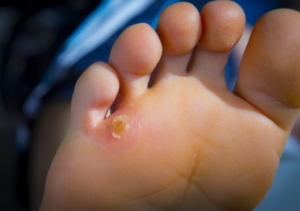Corns and calluses are thickened areas of skin that develop as a protective response to repeated friction or pressure. While they can occur anywhere on the body, they are most commonly found on the feet, especially the toes and soles. Though generally harmless, they can cause discomfort and pain if left untreated.
Causes of Corns and Calluses
- Friction and Pressure: Repeated rubbing or pressure, often from ill-fitting shoes, can lead to the development of corns and calluses.
- Foot Deformities: Structural issues such as bunions, hammertoes, or other foot deformities can increase pressure on certain areas, leading to thickened skin.
- Activities: Activities that put repetitive pressure on the feet, such as running or walking, can contribute to the formation of corns and calluses.
- Manual Labor: Using tools or engaging in activities that cause repetitive friction on the hands can lead to calluses.

